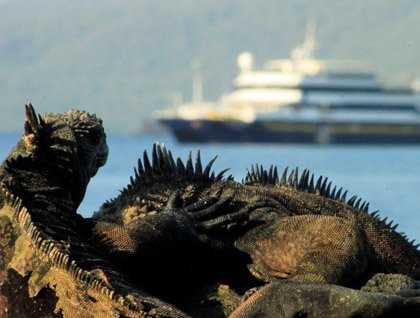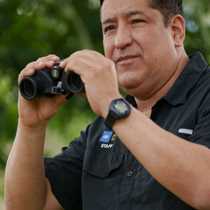We started the day off with an early walk on Espumilla Beach. This remote and paradise-like location has wonderful attractions - a long white beach that’s also a sea turtle nesting site, a thick mangrove forest, a shallow lagoon, and a fabulous view from up the little hill that crowns the trail filled with a mature forest. Darwin finches can be heard everywhere. We had two options here, a long natural history walk and a shorter photography-specific walk.
After this visit the National Geographic Islander was repositioned to Buccaneer Cove. This was a favorite location for pirates, buccaneers, and privateers in the past because it offered so many supplies, such as fresh water, firewood, and (unfortunately) plenty of tortoise meat.
After breakfast, we spent the rest of the morning snorkeling and kayaking. Both activities were excellent. Snorkelers spotted many colorful tropical fish, reef sharks, several rays, and some Galapagos sea lions. Kayakers explored the rocky coast and had a blast under the impressive tuff cliffs and into the shallow caves of the area. We were all back by noon after spending a busy but great morning!
After lunch naturalist Fernando Sanchez gave a talk about Charles Darwin. Immediately after, in the late afternoon, at around 1545 we disembarked at Puerto Egas. We had a couple of options - a long and peaceful walk along the coastline or to spend the whole afternoon swimming, snorkeling, and/or relaxing at the black sand beach. A tropical rain accompanied us at the beginning of these activities reminding us that we are amidst the wet warm season in Galapagos. After a while the rain calmed down and the place came alive. The sun made a brief appearance providing a soft warm light that was perfect for photography.
A walk we took followed a path nearby the ocean that was full of bewildering lava shores and crevices. Shore birds and Galapagos fur seals were highlights among the amazing amount and diversity of wildlife to see. Vibrant Sally lightfoot crabs against the dark black lava, lava herons chasing them, invertebrates in the tidal pools, American oystercatchers, brown pelicans, marine iguanas, and Galapagos sea lions were also seen here and there.
Reluctantly we came back on board. Santiago Island was as its best today giving us a combination of wilderness, various weather conditions, amazing landscapes, and great encounters with the abundant Galapagos fauna.







